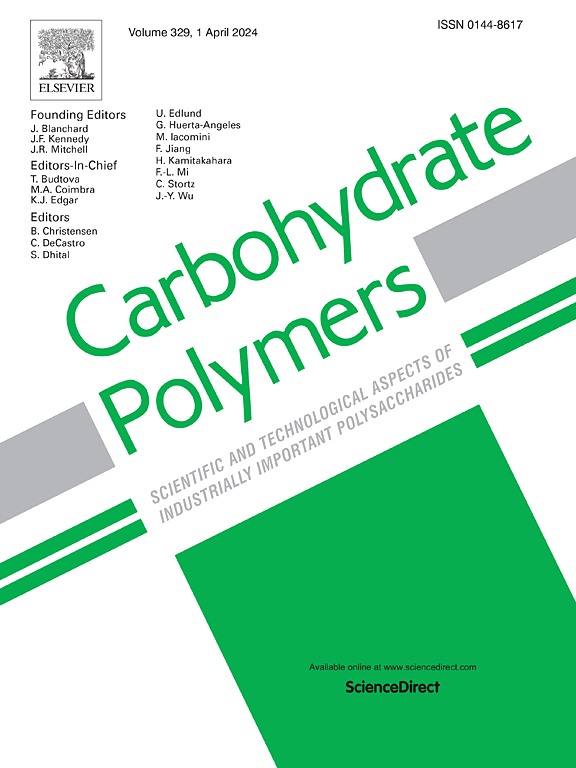Chitosan/oxidized cellulose composite nanofiber sponges: a rapid and effective hemostasis strategy for non-compressible hemorrhage
IF 10.7
1区 化学
Q1 CHEMISTRY, APPLIED
引用次数: 0
Abstract
Non-compressible hemorrhagic wounds, prevalent in combat and mass trauma scenarios, are characterized by arterial injury-induced exsanguination and geometrically complex wound morphology that challenges conventional hemostatic interventions. This paper presents a novel nanofiber hemostatic sponge (CT@GP-HAc), made from 2,2,6,6-tetramethylpiperidine-1-oxyl radical (TEMPO) oxidized cellulose nanofibers (TOCN) and chitosan nanofibers (CSNF), crosslinked with genipin (GP) in an acetic acid atmosphere. The sponge features excellent shape memory and rapid hemostatic capabilities, specifically designed for deep, irregular wounds. Its unique micro-nano composite porous structure enhances blood absorption, blood cell capture, and coagulation factor recruitment. In vitro experiments show that CT@GP-HAc outperforms traditional iRegene® GEL sponges in whole blood coagulation index, coagulation time, and red blood cell and platelet adhesion. Prothrombin time (PT), activated partial thromboplastin time (APTT) and thrombin time (TT) tests reveal that CT@GP-HAc's hemostatic action is independent of the human coagulation mechanism, making it suitable for patients with coagulation disorders. Biocompatibility tests indicate an extremely low hemolysis rate and non-cytotoxicity, supporting its clinical application. In vivo studies confirm CT@GP-HAc's effectiveness in reducing blood loss and shortening hemostasis time. These findings highlight the potential of CT@GP-HAc as a next-generation hemostatic material for managing non-compressible hemorrhagic wounds.

壳聚糖/氧化纤维素复合纳米纤维海绵:一种快速有效的非压缩性出血止血策略
不可压缩性出血性伤口普遍存在于战斗和大规模创伤场景中,其特征是动脉损伤引起的失血和几何形状复杂的伤口形态,这对传统的止血干预提出了挑战。采用2,2,6,6-四甲基哌啶-1-氧自由基(TEMPO)氧化纤维素纳米纤维(TOCN)和壳聚糖纳米纤维(CSNF)在醋酸气氛下与吉尼平(GP)交联制备了一种新型纳米纤维止血海绵(CT@GP-HAc)。海绵具有优异的形状记忆和快速止血能力,专为深,不规则伤口设计。其独特的微纳复合多孔结构增强了血液吸收、血细胞捕获和凝血因子募集。体外实验表明,CT@GP-HAc在全血凝血指数、凝血时间、红细胞和血小板粘附性方面优于传统iRegene®GEL海绵。凝血酶原时间(PT)、活化部分凝血活酶时间(APTT)和凝血酶时间(TT)试验显示CT@GP-HAc的止血作用不依赖于人凝血机制,适合于凝血功能障碍患者。生物相容性试验表明其溶血率极低且无细胞毒性,支持其临床应用。体内研究证实CT@GP-HAc在减少失血和缩短止血时间方面的有效性。这些发现突出了CT@GP-HAc作为下一代止血材料用于处理不可压缩的出血性伤口的潜力。
本文章由计算机程序翻译,如有差异,请以英文原文为准。
求助全文
约1分钟内获得全文
求助全文
来源期刊

Carbohydrate Polymers
化学-高分子科学
CiteScore
22.40
自引率
8.00%
发文量
1286
审稿时长
47 days
期刊介绍:
Carbohydrate Polymers stands as a prominent journal in the glycoscience field, dedicated to exploring and harnessing the potential of polysaccharides with applications spanning bioenergy, bioplastics, biomaterials, biorefining, chemistry, drug delivery, food, health, nanotechnology, packaging, paper, pharmaceuticals, medicine, oil recovery, textiles, tissue engineering, wood, and various aspects of glycoscience.
The journal emphasizes the central role of well-characterized carbohydrate polymers, highlighting their significance as the primary focus rather than a peripheral topic. Each paper must prominently feature at least one named carbohydrate polymer, evident in both citation and title, with a commitment to innovative research that advances scientific knowledge.
 求助内容:
求助内容: 应助结果提醒方式:
应助结果提醒方式:


